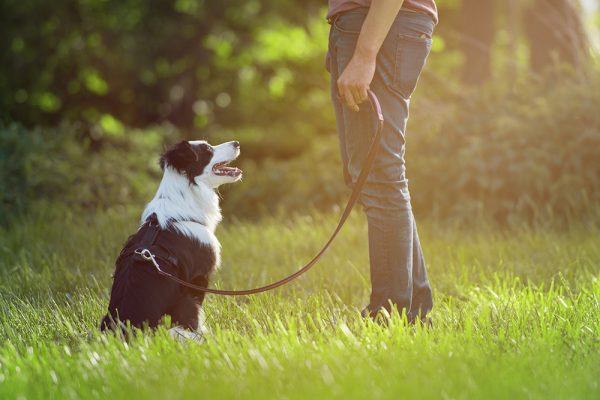In this article
View 2 More +Not all parts of dog ownership are pleasant, and dealing with behavior like your male dog humping other male dogs is one of those. Why do dogs do this, anyway? You may know that humping is a sexual behavior for dogs, but there are a few other causes: stress, a way to initiate play, or it can be a display of dominance. In some cases, it’s even because of a medical issue your dog or the other dog is facing. For dogs, it’s not always a strictly sexual act and can be taken multiple ways, depending on the circumstances.
Intact males are more likely to mount or hump because their hormones urge them to mate with females, but neutered males and even spayed females can display this behavior as well. While neutering can be a possible solution, preventing or stopping mounting and humping has to do with socialization and training as well. Let’s talk some more about that down below, as well as what you can do to stop your male dog from humping other males in the future.

The 5 Causes of Male Dogs Humping Other Male Dogs
You know that humping can be caused by several different things, but they can be tricky to distinguish at first glance. Let’s talk a bit more specifically about what could be making your dog hump, so that you can respond appropriately in the future.
1. Hormonal Behavior
Puppies from 6 to 24 months old are going through adolescence, which includes a flood of confusing hormones. They feel compelled to mate with females, but this behavior is difficult to control at the time and can manifest when playing with other males too. Sometimes, dogs simply learn that humping feels good, which creates feel-good hormones in their brain as well. It can bleed over to people and inanimate objects as well.

2. Display of Dominance
Older and more dominant dogs use mounting and humping as a way to establish their social dominance over another dog. Poorly socialized dogs are more likely to do this because they haven’t been shown how to act toward other dogs and people, but any dog can do it. The dog being mounted could also react negatively to this, so it’s important to socialize your dog properly and nip this behavior in the bud.
3. Playful Gesture
To dogs, humping is a natural behavior that doesn’t carry any moral implications. Often, they’re overly excited in play and so they resort to humping—that’s the end of it. Male and female dogs, both intact and fixed, are often observed mounting or humping other dogs of either sex. It’s usually not a big deal between two dogs in a family, but it can be taken the wrong way at, say, the dog park by an unfamiliar dog. Remember to make sure to separate your dog if another dog isn’t taking this playful gesture well.

4. Stress
Humping can be a stress-relieving, self-soothing activity for anxious dogs. Changes in the home environment or a new dog in the house can make this behavior worse, so it is important that you identify the stressor and remove it if you can. Other common stressors include new babies, a new routine for you, or house moves. However, it’s up to you to try to figure out your dog’s trigger and respond appropriately. If you’re unsure, it might be best to talk to a vet or an animal behaviorist.
If you need to speak with a vet but can't get to one, head over to PangoVet. It's our online service where you can talk to a vet online and get the advice you need for your pet — all at an affordable price!
5. Medical Problems
Several health conditions affecting your dog’s genitals or urinary system could be causing them to hump to relieve discomfort or pain.
- Urinary tract infection (UTI): A dog with a UTI might hump to relieve the painful sensation in their private area.
- Skin infection: A skin infection on your dog’s pelvic area or around its genitalia can make them excessively lick and hump to relieve some of the discomfort.
- Priapism: An uncomfortably persistent erection that can become painful and slightly alleviated by humping objects, people, or other animals.
If you suspect there may be a medical condition going on, consult your vet as soon as you can to get to the bottom of it.


Does Humping Other Dogs Have Risks?
It might be a natural behavior, but some very real risks could arise from your dog incessantly humping everything in sight. It’s embarrassing, for one thing, especially if it happens often. Nobody likes that one dog at the dog park who humps all the other dogs, you know?
Your dog could hump the wrong dog or person that doesn’t take it well and you could even have an altercation on your hands. Your dog could get into a fight and potentially get hurt or hurt another dog, which nobody wants. The mental image of a Chihuahua humping a Rottweiler is a little funny, but the Rottweiler may not think it’s so funny and could severely injure your beloved pup. It’s best to train this behavior out of your dog or speak to your vet for more advice.
If frequent humping starts from a young age and continues through adulthood, it makes it even more challenging to get rid of. If caused by stress and the source of the stress is not addressed, the behavior could become worse over time.
How to Stop Inappropriate Mounting and Humping
Humping can’t always be completely eliminated, but there is hope for reducing it! Most of the time, when a dog mounts or humps, it’s because of improper training or socialization. When a puppy is properly and extensively socialized, it learns about how to appropriately interact with people and other dogs. Older dogs that hump and have always humped can be more challenging to reform, but it usually just takes more time and patience. Let’s see what you can do about this awkward situation down below.
- When you catch your dog humping at any time, immediately tell them “no” and redirect them to a more appropriate activity, like a squeaky toy.
- If your dog humps you or anyone in your home, immediately stop what you’re doing and leave the room. This sends the message that humping is unacceptable and it leads to the end of attention from you.
- Avoid harsh words or physical punishment—it doesn’t work and may actually exacerbate fearful behavior.
- Consider enlisting the help of a professional dog trainer who knows how to get to the root of this behavior and stop it for good.

Conclusion
Humping is a normal dog behavior that can be excessive in some situations, and any dog of either sex can hump. It’s important to teach your dog not to hump through careful redirection and ignoring the behavior without indulging it. It’s a fine line, to be sure, but you can always consult a dog trainer or your vet if you feel lost.
See also:
Featured Image Credit: atiger, Shutterstock



















